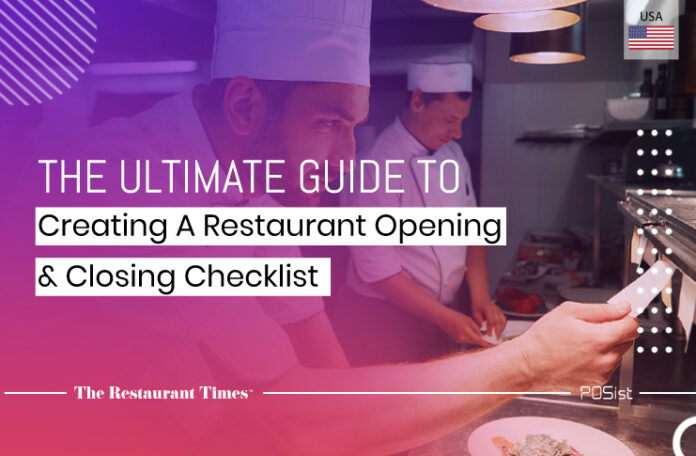There are several ebbs and flows in every restaurant business – from the very moment the signboard flips “open” to the time it capsizes to “closed.” However, as challenging as they may seem at times, these ups and downs in the business serve as crucial reminders that prompt you to diligently prepare before your customers set foot in your restaurant and carefully plan after they depart at the dusk of the day. Since priorities trigger actions, what better than to prepare and plan by creating a detailed restaurant checklist of your everyday priorities.
Opening Checklist For Your Restaurant
The whole purpose of a checklist is to break down complex processes into simple, actionable steps. Hence, based on your restaurant’s processes and demands, feel free to rearrange and further break down the step-by-step opening checklist we’ve mentioned below.
1. Determination Of Tasks
“The beginning of wisdom is the definition of terms,” said Socrates. Armed with Socratic insight, restaurant owners and managers must first determine which tasks should be added to their restaurant checklist.
To determine your checklist items, here’s what you should do:
- Seek help from industry leaders: Because experience trumps precept, reach out to experienced industry leaders in your restaurant niche and let them help you determine opening tasks that demand your attention. You can do so by either hiring experienced strategic managers or by equipping yourself with knowledgeable resources.
- Use real-time analytics: Harness the benefits of top-notch technologies and analytics to list down your opening checklist items. By doing so, you can regularly access real-time information, tweak your checklist accordingly, and thereby, embrace the unpredictability of the restaurant business.
Separately determine a kitchen opening list that includes:
- Food prep guidelines.
- Menu details listing the day’s specials and excluded items.
- Raw materials are required for timely food preparation.
- Preheating time for appliances before opening.
- Stocking and restocking requirements of different stations at the restaurant.
Once the determination of tasks is out of the way, you can move on to the organization of your tasks.
2. Logical Organization Of Tasks
Owing to the complexity of the restaurant business, you might end up with an overwhelmingly colossal list of tasks on your checklist. Herein lies the importance of organization. Organize your list in such a way that:
- Even the most trivial tasks seamlessly transition to the next. For instance, you’ll have to preheat your ovens and marinade relevant food items before food preparation.
- Every task is categorized based on the goals of respective staff members.
To confirm that no stones are left unturned, involve all staff members in the restaurant checklist creation process. By doing this, you can further streamline your processes and guarantee efficient services to your customers.
Time and again, you’ll have to optimize your checklist either based on your intuition or real-time data. To make hassle-free changes to your list, save it in an easy-to-update format. Once you’ve updated the restaurant checklist, take a printout and place it in an area that’s accessible to all employees. As a better alternative, you can also use CRM services to keep your employees updated on every minor change that goes into your opening checklist.

Closing Checklist For Your Restaurant
As a restaurant owner, there’s no better feeling than looking back at every little accomplishment on your checklist. However, since foresight is as important as hindsight, your day at your restaurant doesn’t end before you prepare for the next one by following a systematic closing protocol. While the overall process of designing a closing checklist is no different from that of the opening one, the details vary.
1. Determination Of Tasks
Yet again, narrow down your restaurant’s day-to-day activities to an exhaustive list. This step is especially essential because while wrapping for the day, many employees might overlook some critical tasks that could ultimately lead to dire consequences.
Hence, from health violations to sanitization, from food storage to customer feedback–every closing task should be set in stone to ensure a seamless opening the next day. Here are some of the most vital closing tasks that should land on your restaurant checklist:
- Flipping your signboard from “open” to “closed.”
- Sanitizing all open surfaces.
- Refilling condiments.
- Disposing trash.
- Restocking tissues and linen for the next day.
- Turning off all appliances, especially heating devices.
- Updating your end-of-the-day report based on customer feedback.
- Sanitizing storage devices such as freezers and refrigerators.
- Regulating an ideal temperature for food storage.
- Updating the opening checklist for the next day.
- Turning off the lights.
Based on your ever-changing demands and process patterns, feel free to add new and eradicate old tasks from your closing checklist.
2. Logical Organization Of Tasks
Similar to the opening list, organize your restaurant checklist by listing out each task based on where it lies in the overarching process. Following this, categorize the tasks with respect to the individual goals of each department in your restaurant. While at it, ask your employees to go through the list and suggest timely changes if required.
Once updated with new insights and employee feedback, the list should be available to all employees long before they begin the next day.
Since the closing of one day marks the inception of hope for the next one, hope for the best and be well-prepared for the worst so that nothing can disrupt your daily restaurant activities. You can achieve this by further optimizing your checklists using data-driven insights offered by robust subscription-based software.


















